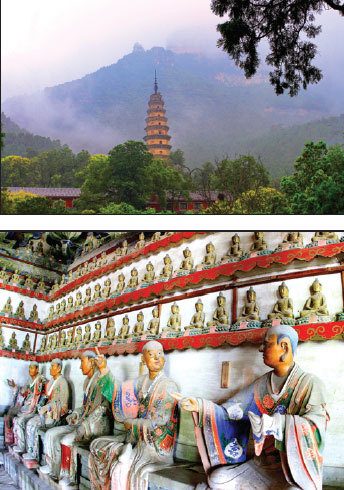Centuries-old temple remains undisturbed
Lingyan Temple has been one of the four most important temples in China since it was built more than 1,600 years ago in Jinan, Shandong province. Its peak lasted from the Tang Dynasty (618-907) to the Ming Dynasty (1368-1644), when it had more than 50 large buildings and over 500 monks.
The temple, which perches in a quiet valley on the north range of Mount Tai, had remained unknown to many until 1982, when it was listed as a key cultural relic site under State protection and was opened to tourists.
Mount Tai became a World Natural and Cultural Heritage site in 1987, and Lingyan Temple is a part of the mountain's cultural heritage. Besides its significance in Buddhist history, the temple has breathtaking natural views at an altitude of 700 meters.
In the mid-Qing Dynasty (1644-1911), the Emperor Qianlong stayed at the temple eight times on his way to inspect the south of China from Beijing, because of the picturesque views and the quietness of the temple.
The natural environment is well protected. The peaks surrounding the temple look like several monks chanting sutras and the forest is home to hundreds of kinds of birds and animals.
East of the temple, at the foot of a steep cliff, are three natural springs all beside each other. To the north and south of the temple, there are five more springs. The flow of the spring water is constant and the water is crystal clear. They are the main water source for the temple, as well as an important reason why Lingyan Temple has survived the twists and turns of a long history.
A sandal tree with more than one thousand years' history still flourishes beside one of the springs. There are many tales about the tree, the springs and the mountains.
Along the north-south central axis of the temple are the Hall of Heavenly Kings, a bell tower and a drum tower, Great Buddha's Hall, Five-Flower Hall, Thousand-Buddha Hall, Prajna (wisdom) Hall and Tripitaka Sutra (Buddhist texts) Pavilion. The main structures and foundation of these buildings date back to the Song Dynasty (960-1279), and the roofs and walls were rein-forced in the Qing Dynasty.
The Thousand-Buddha Hall is a must-see. Besides three large gilded Buddha statues, there are about one thousand small wooden Buddha sculptures placed on layers of shelves on the wall.
There are 40 colorful clay sculptures of monks, most of which are believed to be made in the Song Dynasty according to 40 real-life monks in the temple. Each of the monks has his own facial expressions and gestures, and even the veins on their forearms and necks are vividly carved. Some are smiling, some are angry and some are pondering. The colors, from mineral substances, remain fresh and bright today.
"The clay sculptures seem to have life. Each one of them teaches the viewer a lesson about life," said Zhang Ruidong, a local traveler. "You can find yourself among them. My looking is like a process of dialogue with them."
During a renovation project in 1982, workers accidentally found silk-made organs, Buddhist texts, copper coins and ancient books in compartments within these clay figures.
There are many well-preserved delicate stone and wood embossments, and frescos on the buildings, telling Buddhist stories. Several stone tablets inscribed with records of the main renovation projects of the temple in the past 1,000 years still stand at corners of the shady courtyard.
Li Deguang, a local traveler, said: "I visited the temple in 1983. It looks exactly the same after 33 years. The temple is an ideal, reminiscent place, while the city has changed too much to be recognized even by locals if they have left for 33 years."
In the back of the temple is Pratyeka (meaning 'every'), a 55.7-meter pagoda of the Song Dynasty, and a monk graveyard covering a period of about 1,500 years. It took the Song people 65 years to build the eight-angle nine-story pagoda with brick, stone and clay. The graveyard has 167 stupas, which refers to a kind of dome-shaped monument used as a Buddhist shrine for relics, and 81 tombstones inscribed with epitaphs.
"Tourism brings about commercialization, against which the Lingyan Buddhists must be vigilant and try to maintain the purity and tranquility of the temple, making it a habitat for hearts," said Hong'en Master, a monk in Lingyan Temple. "We are responsible for handing down the temple to the next generation, just as we received it from our masters."
Contact the writers at liyang@chinadaily.com.cn
|
Top: Pratyeka in Lingyan Temple. Above: Clay sculptures in ThousandBuddha Hall in the temple. Ju Chuanjiang / China Daily |















